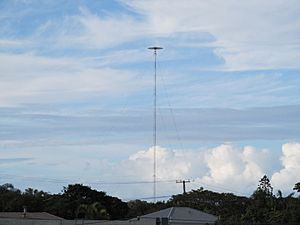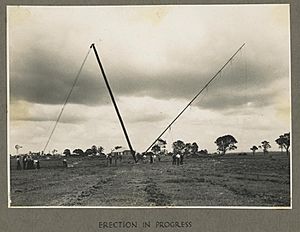Bald Hills Radiator facts for kids
Quick facts for kids Bald Hills Radiator |
|
|---|---|

ABC tower Bald Hills, 2013
|
|
| Location | 99 Kluver St, Bald Hills, City of Brisbane, Queensland, Australia |
| Area | 43 hectares (110 acres) |
| Official name: National Broadcasting Service Radio Transmission Centre | |
| Reference no. | 153 |
| Lua error in Module:Location_map at line 420: attempt to index field 'wikibase' (a nil value). | |
The Bald Hills Radiator is a special place in Bald Hills, City of Brisbane, Queensland, Australia. It's a radio transmission centre, which means it sends out radio signals. It's also known as the National Broadcasting Service Radio Transmission Centre.
This important site is listed on the Brisbane Heritage Register. It sends out all the Brisbane AM radio shows for the Australian Broadcasting Corporation (ABC). Today, a company called BAI Communications owns the site. They help broadcast ABC radio and TV signals across Australia.
Contents
The Story of Bald Hills Radiator
Early Radio Days in Brisbane
Long ago, radio signals were sent right from the middle of Brisbane city centre. The first radio station, 4QG, started broadcasting in 1925. Its first transmitter was in a building called the Executive Building.
Later, a stronger transmitter was put on the eighth floor of another building. In 1930, the Australian Broadcasting Commission (now the ABC) became involved. The Postmaster General's Department (PMG) handled all the technical work.
In 1935, a team looked at a farm in Bald Hills. They thought it would be a good spot for a powerful radio transmitter in the future. At this time, radio station 4QG had been on air for ten years. The National Broadcasting Service (NBS), which became the ABC, had been around for five years.
Another radio station, 4QR, started in 1938. It sent its signals from a building in Elizabeth Street.
Moving Radio Out of the City
When World War II began, Brisbane's sky had five tall radio towers. Two were for 4QG and one for 4QR. The other two were for commercial radio stations.
In 1940, land was bought in Bald Hills for the new radio centre. The first tall aerial was put up in 1941. It was 262 feet (80 meters) high. The main building was made of brick. It was built by Thomas Frederick, starting in October 1941. The old farm buildings were taken down around this time.
In March 1942, General Douglas MacArthur came to Australia. He was the leader of the Allied Forces in the South-West Pacific. His headquarters were in a building in Queen Street, Brisbane. People worried that the tall radio towers in the city could help Japanese planes find MacArthur's office. This made it urgent to move the transmitters out of the city.
The first radio signals from Bald Hills were for 4QR. This happened on March 24, 1942. The transmitter had been moved from the city the night before. In April 1942, the 4QG transmitter also moved to Bald Hills. It went to a different site nearby. People living in Bald Hills were not happy about the risk of attack moving to their area.
Because the National Broadcasting Service (NBS) only reached Brisbane, Rockhampton, and Townsville, they decided to use short wave radio. This would help reach other parts of Queensland. The VLQ short wave station started broadcasting on February 17, 1943.
More land was bought for the site until July 1943. The Australian Government took over 114 acres (46 hectares) from J W Guy. The transmitter building was made bigger in 1945-46. After World War II, the current main aerial was put up in 1947. The building was made bigger again in 1962. It was also changed inside in 1968 and around 1994 when new equipment was added.
Later, small parts of the land were used for road widening. Today, the site is 43 hectares (about 106 acres).
What's Inside the Centre?
The National Broadcasting Service Radio Transmission Centre is a large area of about 43 hectares. It's located at 99 Kluver Street in Bald Hills.
The VLQ STCA880A transmitter is a very old but powerful short wave transmitter. It was built using technology from before transistors and silicon chips existed. It used very large glass and metal radio valves. These valves needed a special water cooling system to work.
When it was running, the transmitter looked amazing. The large glass valves glowed red, and the cooling system made a special sound. An engineer named Sanderson once wrote that these old units had a "personality" that modern equipment lacks.
The STCA880A transmitter was very strong and reliable. It worked for 45 years, from 1943 until 1988. It was finally stopped because the special valves it needed were no longer made.
This Bald Hills unit was the third of its kind ever built. The first two were for the Royal Australian Air Force (RAAF). It was the first short wave transmitter for the NBS in Queensland. It was also the second in all of Australia.
To keep the transmitter cool, two pumps were installed in a nearby room. A large fan-cooled radiator was placed outside. The cooling water had to be very pure, so a special machine made distilled water.
The main aerial you see today is a tall, triangular steel structure. It is 204 meters (about 670 feet) high. It is held up by strong cables in three directions. Under the ground, there are 120 copper wires, each 200 meters long. These wires help the antenna work. The antenna is designed to send out two radio frequencies at the same time. This helps reduce fading at night.
Two smaller masts are also on the site. One sends out the ABC NewsRadio service. The other is a backup for the main 200-meter mast.
The main building is on the higher part of the site. It first held the 4QR transmitter in March 1942.
Other buildings at the site include:
- The foreman mechanic's house, built in 1944.
- The emergency engine house, built in 1950.
- The coupling hut, built in 1962.
- Other buildings for transmitters.
Some of the other original transmitters at the site were:
- A standby 4SU-11A (1948).
- A standby 4SU-16C (1951).
- The main 4QG 4SU-64 (1963).
- The main 4QR 4SU-38 (1963).
The older medium wave transmitters were later replaced with modern ones. These new transmitters use MOSFET devices. The short wave transmitters were then turned off. The VLQ9 and VLM4 services stopped, and their antennas were removed.
The original VLQ transmitter is still there. It is kept in the same place where it was installed in 1943. It is fully preserved.
Why is This Place Important?
The VLQ transmitter STCA880A, built in 1943, was the first high frequency transmitter in Queensland. It was the second in Australia. It is believed to be the last of its kind left in the world. It shows how radio used to reach country areas using short wave signals. It was used a lot for broadcasts to Papua New Guinea. This transmitter and the Bald Hills centre were at the start of the short wave radio era.
This site shows an important time when the National Broadcasting Service in Queensland grew very quickly. It helped people in remote areas get radio services for the first time. This made them feel less isolated.
The transmitter was designed in Australia. Most of its parts were made in Australia too, except for some meters and valves. It used water cooling, which was a common technology back then. It worked for 45 years, either full-time or as a backup. It is still in its original spot from 1943.
This transmitter is a very important historical item. It is probably the only one of its kind still existing. Experts have suggested that it should be kept as a special broadcasting exhibit.
The other transmitters at the site, along with the STCA880A, make up Australia's largest collection of old and working radio transmitters in one place. Most of them are still in their original spots.
The main reason this site is important is because of the transmitters it holds. The tall aerial, put up in 1947, has become a well-known landmark in the area. The main building, built in 1941-42, was made for these transmitters. It has been changed or made bigger at least four times since then.
Remembering the Past
There are two sets of photographs that show the history of the site. One set shows the first aerial being built in 1941. The other shows it being taken down in 1987. These photos, with notes by Douglas Sanderson, were given to the John Oxley Library in 1994 by the Institution of Engineers Australia.


